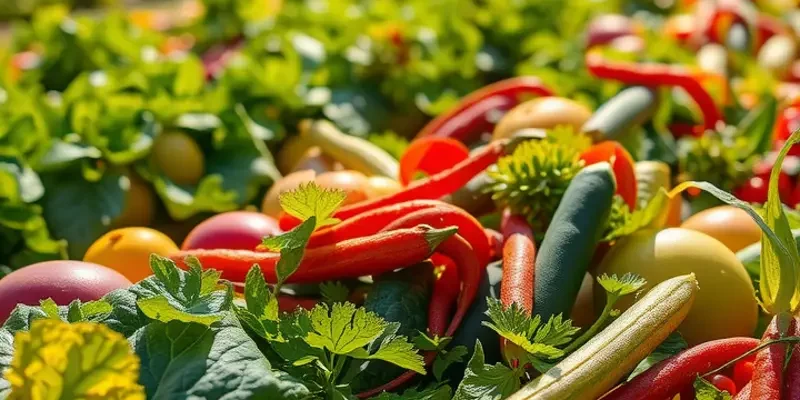As consumers become increasingly aware of the environmental impact of their food choices, many are seeking alternatives to traditional beef. Beef production is resource-intensive and contributes significantly to greenhouse gas emissions. Thankfully, there are a variety of ethical and sustainable alternatives that not only align with environmental values but also promote health and well-being. This journey to greener eating starts with understanding the options available and how they can be incorporated into everyday diets.
Plant-Based Power: Embrace Vegetables and Legumes

As we look for eco-friendly food choices, shifting towards a plant-based diet emerges as an effective strategy. Embracing vegetables and legumes not only means infusing your meals with varied flavors but also reducing your environmental impact. This chapter explores the versatility of plant-based foods, their nutritional richness, and how they can fit seamlessly into your lifestyle.
Vegetables and legumes offer a plethora of nutrients. Leafy greens like spinach and kale are rich in iron and calcium, crucial for maintaining bone health. Carrots and sweet potatoes supply a generous dose of beta carotene, important for eye health. Legumes, including lentils, chickpeas, and black beans, are celebrated for their high protein and fiber content, which helps maintain satiety and supports gut health.
Beyond nutrition, the environmental impact of plant-based foods is considerably lower than beef production. Producing a kilogram of beef requires up to 15,000 liters of water, whereas most vegetables need only a fraction of that. Additionally, legumes enrich soil with nitrogen, reducing the need for synthetic fertilizers.
Integrating these plant-based ingredients into your diet can be simple and delicious. Start with a hearty lentil soup, which combines lentils, chopped tomatoes, carrots, and celery. Season it with cumin and coriander for a comforting meal. For a quick weeknight dinner, try a stir-fry with tofu, bell peppers, broccoli, and a splash of soy sauce.
Grains like quinoa and barley complement legumes and vegetables well, forming a complete protein source. Quinoa salad, combined with black beans, corn, diced tomatoes, and avocado, makes for a nutritious and satisfying dish. Additionally, learn more about easy plant-based eating to ensure a smooth transition to this sustainable lifestyle.
For those unfamiliar with these ingredients, begin slowly. Replace one meat-based meal per week with a plant-based platter. Gradually expand your recipes by exploring various cuisines that naturally center around plant-based ingredients. The diversity is expansive—from Indian dal made with lentils and spices to Mediterranean falafel crafted from chickpeas.
Experimentation is key to discovering what you enjoy. Why not try a chickpea curry or a vibrant veggie stir-fry? Not only will you be doing your part for the planet, but you will also enhance your palate with flavors from around the world.
Ultimately, embracing vegetables and legumes is a potent step towards conscious eating. It champions both environmental sustainability and personal health, offering a palate of possibilities to savor and explore.
Innovative Proteins: Grains, Tofu, and Alternatives

In the quest for sustainable protein sources, grains like quinoa shine as nutritional powerhouses. Quinoa is rich in essential amino acids, making it a complete protein. It requires less water compared to meat production, lowering its overall environmental impact. Incorporating quinoa into meals can be as simple as swapping it for rice or using it in salads and bowls.
Chickpeas are another versatile option, packed with protein and fiber. They thrive in arid conditions, reducing the need for excessive irrigation. From hummus to stews, chickpeas offer a hearty and nutritious alternative to meat. For inspiration, visit our minimal prep dinner ideas for quick and delicious chickpea recipes that highlight their culinary versatility.
Tofu and tempeh, both derived from soybeans, have long been staples in plant-based diets. Tofu absorbs flavors well, making it ideal for a variety of dishes. Tempeh, with its nutty taste and firm texture, is rich in probiotics due to its fermentation process. Soy cultivation can be resource-intensive, but choosing organic and locally-sourced varieties helps mitigate its environmental footprint.
Beyond traditional plant sources, the rise of cultured meat offers a glimpse into the future of sustainable eating. Lab-grown meats are produced by cultivating animal cells, eliminating the need for livestock farming. This innovation has the potential to drastically reduce land and water use, as well as greenhouse gas emissions. While still in its nascent stages, cultured meat is steadily gaining traction as a viable sustainable protein source.
As the landscape of food production evolves, these protein alternatives represent a shift towards environmentally conscious eating. They cater to ethical concerns while addressing the growing demand for sustainable food solutions. Incorporating these proteins not only benefits personal health by offering diverse nutrients but also contributes positively to the planet’s wellbeing. Embracing such alternatives is a progressive step in the journey towards sustainable living.
Final words
Transitioning to ethical alternatives to beef is not just a trend; it’s a critical step towards a sustainable future. By embracing plant-based foods and innovative protein sources, you will not only reduce your carbon footprint but also discover a wealth of flavors and culinary experiences that promote health and well-being. Making eco-conscious choices involves small steps that can lead to significant changes in your lifestyle. Remember, every sustainable decision made contributes to a larger movement for a healthier planet. Together, we can enjoy delicious meals while caring for the environment.








